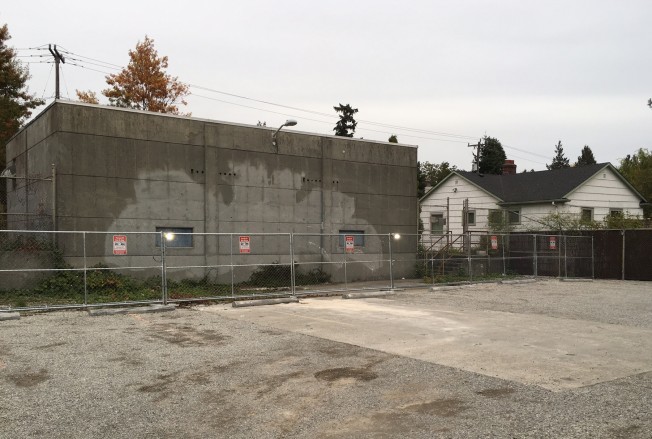By Tracy Record
West Seattle Blog editor
Neighbors of the former Avalon substation building by the southwest end of the West Seattle Bridge say they were surprised to find out, after years of living nearby, that it is contaminated with mercury and set for demolition.
Wednesday afternoon, they gathered with Seattle City Light and Department of Construction and Inspections reps and City Councilmember Lisa Herbold to try to clarify what happened and what’s planned for the site after the building is torn down and the contamination cleanup.
Members of the Junction Neighborhood Organization and NERD (Neighbors Encouraging Reasonable Development) said there had been no outreach/notification about plans for the site at 3243 SW Genesee – they just happened to find out what was planned, and started the inquiries with the city that led to the Wednesday meeting. City Light owns the two single-family-housing-zoned parcels on which the building sits, as well as the property to the west that has been long leased to restaurants, currently Pecos Pit Barbecue (WSB sponsor). As reported here in 2011, the site was briefly discussed for potential redevelopment – the parcel holding the restaurant is zoned for up to 65′ – but that was scrapped.
Bill Devereaux, City Light’s environmental manager, told the group gathered at the Sisson Building/Senior Center that the building had stored electrical equipment known as “rectifiers” for the long-dismantled Seattle trolley system. That’s where the mercury came from. It’s not a current public-health risk, as it’s been encased with concrete since 2010, but the city wants to get it out for once and for all: “I can only get to the mercury by taking down the building, and getting the conduit out of there. … Long term, we’ve always planned on doing this.” (Added: From the SDCI files related to the demolition, here’s the consultant report on the site contamination.)
The permit process hasn’t been under way that long, however (city records show the demolition-permit application was filed three weeks ago, but there’s a “site plan” in the file dating back three more months, to June).
Devereaux said SCL had been trying to create an inventory of sites with mercury after a mercury spill at a substation in Bothell almost a decade ago. That led them to start trying to track down sites with mercury, listing equipment that has mercury in it, including some with “live” equipment. When the Avalon building was “taken care of as an immediate health risk” in 2010, he said, they weren’t sure what they would do next, and when. But they sent in a consultant last year. One neighbor said he saw a surveying crew last summer and contacted City Light to ask about it but was told nothing was imminent.
Neighbors said they also wanted clarification on the status of the site, and whether it was for sale or not. Councilmember Herbold noted that City Light said the property was not in the disposition process, but it was listed online as “excess property.”
Mary Fleck from Seattle Green Spaces Coalition said that they learned it was on the “surplus list” two years ago and asked about the possibility of using it as a “gateway” property. Then, she said, they were told it was being taken off the list, with the possibility of adding the site to the restaurant lease to the east – and “we feel we’ve been snookered and lost an opportunity.”
JuNO’s René Commons pointed out that they had a meeting two years ago to vision the property’s future and were told it was for sale. That was before City Light announced (as first reported here) a year and a half ago that Pecos Pit had leased the former Beni Hoshi Teriyaki building.
Herbold said it seems clear the community had expressed an interest and there should have been a conversation. One city staffer said that leasing city-owned property, as opposed to selling it, doesn’t require a community-notification process, but there should have been some sort of public communication.
Part of the ex-substation site, south of the building, has been fenced off as extra parking for Pecos Pit since the restaurant opened last June. What kind of permit had been required and obtained wasn’t clear; permanent use as a parking lot would require rezoning, SDCI said, but there is a year’s worth of permitting that could be obtained and would require public notice.
“It would be foolish economic-wise to clean up this site just to be a parking lot,” Devereaux suggested, while saying the site’s future was up to different divisions of City Light. (We asked Pecos Pit today whether they were in any sort of talks for the ex-substation site; the point person for the West Seattle site is out of town, we were told, but we’ll add the reply when we get it.)
The conversation ended with a plan to organize a followup meeting about the ex-substation’s future with a City Light decisionmaker, such as Lynn Best, director of City Light’s Environmental Affairs & Real Estate Division, before month’s end. The utility is hoping to tear down the building before the end of the year.



| 7 COMMENTS